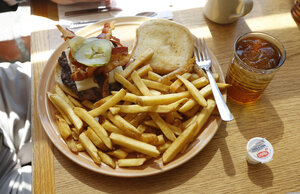Google wants to count the calories in your food photos
Snapping an Instagram photo of your brunch could help you count calories, courtesy of new technology from Google. Will it help change people’s eating habits?

A bacon cheeseburger with french fries is served at the Howard Johnson Restaurant in Bangor, Maine.
Robert F. Bukaty/AP/File
Sure, that Valencia-filtered Instagram post of chocolate peanut butter cake is a guaranteed way to make your Internet friends jealous. But Google thinks it can also be a way to keep track of your diet.
The tech giant is developing technology that could count calories in those crave-worthy food photos. As first reported by Popular Science, Google scientist Kevin Murphy unveiled the project last week at Re-Work Deep Learning Summit, a Boston event showcasing developments in Artificial Intelligence (AI).
The technology would use a learning-capable form of AI to analyze foods in a photo and estimate how many calories are on the plate based on previously gathered data. “It's called Im2Calories, and in one example, the system looked at an image, and counted two eggs, two pancakes and three strips of bacon,” Popular Science explains. “Since those aren't exactly universal units of measurement, the system gauged the size of each piece of food, in relation to the plate, as well as any condiments.”
As anyone who’s ever kept a food diary knows, counting calories, particularly when dining out, can be a messy, inexact process with many factors to weigh, including but not limited to portion size, added sauces, and preparation method. Im2Calories would aim to eliminate such guesswork by drawing from learned statistical data and letting users offer their imput when the algorithm makes a mistake – like correcting the software if it identifies fried eggs as poached eggs, Murphy said during his presentation. “We semi-automate….if it only works 30 percent of the time, it’s enough that people will start using it, we’ll collect data, and it will get better over time."
If effective, it would also streamline the process of keeping a food diary – something shown to be a big help for people trying to clean up their diets and lose weight. A 2010 study from the Cleveland Clinic, weight management program, tracking 1,800 adults, found that those who logged everything they at over a six-month period lost 50 percent more weight than those who did not.
The research on the influence of calorie counts is less settled: A 2011 Stanford study found that Starbucks customers ordered six percent fewer calories per visit when calorie counts were posted on menu boards, but other surveys have recorded little to no change. The technology’s chief virtue, then, may be not in changing behavior on a meal-by-meal basis, but in giving users a more seamless way to track their progress over time.
It would also be among the most seamless methods yet for those sticking to a fixed calorie budget to keep track. Other automated calorie counting tools are out there: SmartPlate, a plate equipped with a scale that hooks into a smartphone, is currently gathering funding on Kickstarter. A wide variety of fitness apps, including MyFitnessPal, offer sections for keeping food diaries. But Im2Calories would be among the first to combine automation with an approach that doesn’t require any extra equipment. That could be a big help in the ongoing fight against obesity, which affects over a third of US adults according the Centers for Disease Control and Prevention (CDC).
Less importantly, it could elevate those carefully lit photos of #animalstyle In-n-Out burgers from social media clutter to important data sets. So go ahead and snap away. It’s for science.

